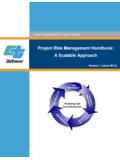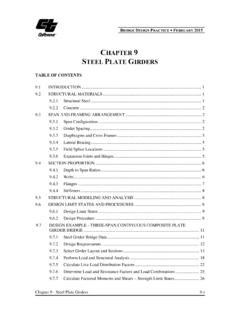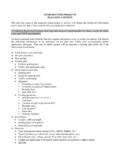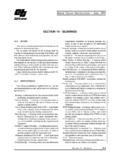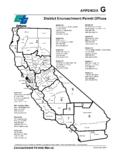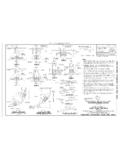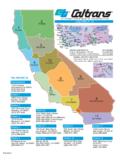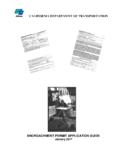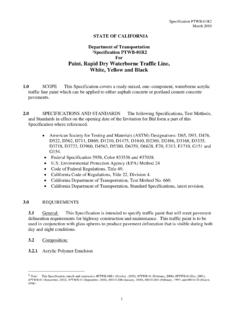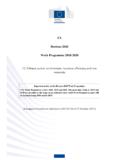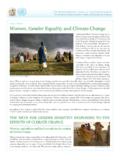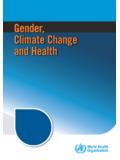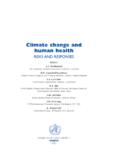Transcription of Cumulative Impacts Assessment Executive Summary
1 Guidance for Preparers of Cumulative impact Analysis Approach and Guidance Cumulative Impacts Defining Cumulative Impacts A Cumulative impact The National Environmental Policy Act (NEPA) and the California includes the total effect Environmental Equality Act (CEQA) require that the direct, indirect, and on a natural resource, Cumulative Impacts of proposed actions be assessed and disclosed. ecosystem, or human Although NEPA and CEQA define the term Cumulative impact similarly, community due to past, present, and future their definitions are slightly different. activities or actions of federal, non-federal, public, and private NEPA Definition entities. Cumulative Impacts may also The NEPA definition of a Cumulative impact comes from the Council on include the effects of Environmental Quality (CEQ), which defines a Cumulative impact as: natural processes and events.
2 Accordingly, the impact on the environment which results from the incremental there may be different impact of the action when added to other past, present, and reasonably Cumulative Impacts on foreseeable future actions regardless of what agency (Federal or non- different environmental Federal) or person undertakes such other actions. Cumulative Impacts resources. can result from individually minor but collectively significant actions taking place over a period of time. (40 CFR ). Source: FHWA, 2003. Interim Guidance: Questions and Answers CEQA Definition Regarding the consideration of Indirect The CEQA definition of Cumulative impact comes from the Office of and Cumulative Impacts Planning and Research (OPR). Section 15355 of OPR's CEQA. in the NEPA Process. Guidelines provides the following context: Cumulative Impacts refer to two or more individual effects which, when considered together, are considerable or which compound or increase other environmental Impacts .
3 (a) The individual effects may be changes resulting from a single project or a number of separate projects. (b) The Cumulative impact from several projects is the change in the environment which results from the incremental impact of the project when added to other closely related past, present, and reasonably Approach and Guidance June 30, 2005. 1. Guidance for Preparers of Cumulative impact Assessments foreseeable probable future projects. Cumulative Impacts can result from individually minor but collectively significant projects taking place over a period of time. In addition to NEPA and CEQA, other regulations call for the Sustainable Systems consideration of Cumulative Impacts . Beyond meeting the requirements of NEPA and CEQA, this guidance document will help practitioners to According to EPA, an ecologically sustainable assess potential Cumulative Impacts on archaeological and historical system must: resources protected by the National Historic Preservation Act (NHPA).
4 (36 CFR 800 or Section 106 Review). The regulations implementing Support biological Section 106 of the NHPA also acknowledge that a project's adverse processes; effects include any that are reasonably foreseeable, even if they may Maintain its level of occur later in time, are farther removed in distance, or are Cumulative . productivity; The consideration of indirect and Cumulative Impacts is required when Function with minimal applying the criteria of adverse effect on historic properties (36 CFR. external management; (a)(1)) and delineating the area of potential effects (APE) (36 CFR. and (d)) as part of the Section 106 process. However, this guidance does not address all components of the adverse effects analysis required Repair itself when by Section 106. stressed. Source: EPA, 1999 This guidance will also help practitioners to assess potential Cumulative Consideration of Impacts on jurisdictional waters of the , including special aquatic Cumulative Impacts in sites, protected by Section 404 of the federal Clean Water Act, which are EPA Review of NEPA under the jurisdiction of the Army Corps of Engineers and the Documents (EPA 315-R- Environmental Protection Agency (EPA).)
5 For more information, see 99-002). Section 404 of the Clean Water Act and the 404(b)(1) Guidelines. This guidance is not intended for Cumulative impact analyses for Biological Assessments prepared to comply with Section 7 of the federal Endangered Species Act (ESA); under Section 7, only non-federal actions are included in the Cumulative impact analysis. Part of your document Since a Cumulative impact is defined in both spatial (geographic) and temporal terms ( , timeframes in which to identify past, present, and A Cumulative impact reasonably foreseeable actions), it is helpful to think in terms of potential analysis is part of the Impacts on the health or status of the resource. Can the resource be environmental described as being in a sustainable state given past, present, and document. It contributes reasonably foreseeable actions?
6 Is the health of the resource declining to the analysis of all of because of human activity? Have conservation actions or recovery plans your project's Impacts . identified by agencies or communities reversed a declining trend for the The level of detail is resource and helped it return to a healthy state? commensurate with the level of detail for the entire environmental document. When a Cumulative impact Analysis is Required CEQ regulations require all federal agencies to consider the Cumulative effects of all proposed agency actions. A Cumulative impact analysis is Approach and Guidance July 27, 2005. 2. Guidance for Preparers of Cumulative impact Assessments required whenever an environmental document is prepared ( , an Environmental Assessment or Environmental impact Statement). The use of a NEPA Categorical Exclusion (or a CEQA Categorical Exemption) for a project indicates your conclusion that the proposed project has no significant impact on the environment.
7 If you have prepared a CE, you have reached the conclusion that Impacts , including the Cumulative Impacts of your project, are not significant. You, therefore, need to consider Cumulative Impacts when determining whether a CE is the appropriate level of documentation for a proposed project. If a CE is appropriate, a formal Cumulative impact analysis is rarely warranted. Eight-Step Approach for Developing a Developing a Cumulative impact Cumulative impact Analysis Analysis 1. Identify Resources No single formula is available for determining the appropriate scope and to Consider in the extent of a Cumulative impact analysis. Ultimately, the practitioner must Cumulative impact determine the methods and extent of the analysis based on the size and Analysis type of the project proposed, its location, potential to affect environmental resources, and the health of any potentially affected 2.
8 Define the Study Area for Each resource. Resource The Cumulative impact analysis builds upon information derived from 3. Describe the Current the direct and indirect Impacts analyses. This makes it tempting to Health and Historical postpone the Cumulative impact analysis until the direct and indirect Context for Each impact analyses are well under way. However, CEQ recommends that Resource potential Cumulative Impacts be considered as early as possible, 4. Identify Direct and preferably during scoping, to identify potential direct and indirect effects. Indirect Impacts of Such early consideration of Cumulative Impacts may also facilitate the the Proposed Project design of alternatives so as to avoid or minimize Impacts . Therefore, do that Might Contribute not defer the consideration of Cumulative Impacts .
9 Instead, as you begin to a Cumulative impact to coordinate with Caltrans environmental specialists about potential direct and indirect Impacts , ask for their input about potential Cumulative 5. Identify Other Impacts as well. Then expect the process to be iterative. As more Reasonably information about direct and indirect Impacts becomes available, use it to Foreseeable Actions further refine the Cumulative impact analysis. that Affect Each Resource The following eight steps serve as guidelines for identifying and 6. Assess Potential assessing Cumulative Impacts : Cumulative Impacts 7. Report the Results 1. Identify the resources to consider in the Cumulative impact analysis by gathering input from knowledgeable individuals and reliable 8. Assess the Need for information sources. This process is initiated during project scoping Mitigation and continues throughout the NEPA/CEQA analysis.
10 2. Define the geographic boundary or Resource Study Area (RSA) for each resource to be addressed in the Cumulative impact analysis. Approach and Guidance July 27, 2005. 3. Guidance for Preparers of Cumulative impact Assessments 3. Describe the current health and the historical context of each resource. 4. Identify the direct and indirect Impacts of the proposed project that might contribute to a Cumulative impact on the identified resources. 5. Identify the set of other current and reasonably foreseeable future actions or projects and their associated environmental Impacts to include in the Cumulative impact analysis. 6. Assess the potential Cumulative Impacts . 7. Report the results of the Cumulative impact analysis. 8. Assess the need for mitigation and/or recommendations for actions by other agencies to address a Cumulative impact .
